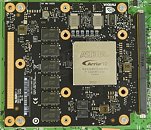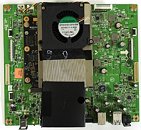- Joined
- May 14, 2004
- Messages
- 28,524 (3.73/day)
| Processor | Ryzen 7 5700X |
|---|---|
| Memory | 48 GB |
| Video Card(s) | RTX 4080 |
| Storage | 2x HDD RAID 1, 3x M.2 NVMe |
| Display(s) | 30" 2560x1600 + 19" 1280x1024 |
| Software | Windows 10 64-bit |
PCPer had the opportunity to disassemble the ASUS ROG Swift PG27UQ 27", a 4K 144 Hz G-Sync HDR Monitor and found that the G-Sync module is a newer version than the one used on 1st generation G-Sync monitors (which of course do not support 4K / 144 Hz / HDR). The module is powered by an FPGA made by Altera (Intel-owned since 2015). The exact model number is Arria 10 GX 480, which is a high-performance 20 nanometer SoC that provides enough bandwidth and LVDS pins to process the data stream.
The FPGA is sold in low quantities for $2000 at Digikey and Mouser. Assuming that NVIDIA buys thousands, PCPer suggests that the price of this chip alone will add $500 to monitor cost. The BOM cost is further increased by 3 GB of DDR4 memory on the module. With added licensing fees for G-SYNC, this explains why these monitors are so expensive.


View at TechPowerUp Main Site
The FPGA is sold in low quantities for $2000 at Digikey and Mouser. Assuming that NVIDIA buys thousands, PCPer suggests that the price of this chip alone will add $500 to monitor cost. The BOM cost is further increased by 3 GB of DDR4 memory on the module. With added licensing fees for G-SYNC, this explains why these monitors are so expensive.


View at TechPowerUp Main Site






 Of course low lag is important,as is fast pixel response. That's why I'll never buy a VA for fps games.
Of course low lag is important,as is fast pixel response. That's why I'll never buy a VA for fps games.